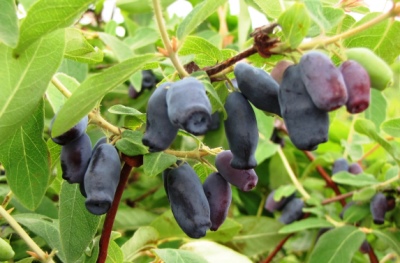
- Authors: Z.I. Archer, I.K. Gidzyuk (Bakchar stronghold)
- Year of approval: 1987
- Growth type: medium-sized
- Description of the bush: semi-compressed, oval
- Escapes: curved, drooping, thin, green
- Transportability: good
- Crown: rounded
- Fruit size: large
- Fruit weight, g: 0,82
- Fruit shape: one-dimensional, wide-drop-shaped, with a depressed apex and a ridge, slightly tuberous
Honeysuckle varieties have recently gained enviable popularity in Russia, especially in the northern regions. One example of this was the Tomichka variety, which, thanks to the efforts of breeders, has many advantages that make it so popular among gardeners.
Breeding history
This culture was bred using Turchaninov's honeysuckle seeds. Work on this has been carried out since 1984 under the leadership of I.K. Gidzyuk and Z.I. Luchnik, and the variety received certification and recognition after tasting tests in 1987.
Description of the variety
Shrubs of culture are classified as medium in height - about 180 cm, differ in sufficient density of branches, with tightly fitting branches. More like a circle in shape.
Large sheets, form an oval, sharpen towards the end. Slight pubescence can be found on the surface of the leaves.
Fruit characteristics
The berries are drop-shaped, with a depressed apex and an extended base, a purple hue, in places completely black. The skin is thin, there are tubercles and plaque typical of the culture. Weight - 0.82 g. Ripe berries are always immediately crumbled to the ground.
Taste qualities
Sweet taste prevails, with slightly noticeable sourness. The berries have a low calorie content. They contain a variety of proteins and fats, as well as C, B vitamins and fiber.
Ripening and fruiting
Tomichka begins to bear fruit after 3-4 years of growth. The crop ripens early, closer to the beginning of July.
Yield
From one shrub, you can get up to 2-3 kg if the crop was harvested on time. The berries reach full maturity 5-6 days after turning blue. During this period, they must be collected.

Self-fertility and the need for pollinators
Self-fertile culture. In order to contribute to the fruiting of representatives of this variety, planted in one area, they need other pollinating varieties:
- Blue spindle;
- Turchaninov;
- Pavlovskaya;
- Bakcharskaya.
It is necessary to plant these varieties at a distance of no more than 50 meters from the Tomichka variety.
Growing and care
The variety goes through an early growing season, and therefore it is recommended to plant young shrubs towards the end of summer.
Instructions for planting seedlings.
- In a favorable place, pits are dug 1.5 meters apart.
- The resulting depressions are filled with a nutrient composition: compost, half of the dug soil, 100 g of potassium salt, double superphosphate and a little wood ash. All this is filled with water.
- Saplings with straightened roots are placed in holes.
- The plant is covered with a nutrient mixture, compacted and filled with water.
- As soon as the soil subsides a little, a little mixture is added so that the neck of the roots can go deeper by 3-4 cm.
- Ditches are made near the trunk and plentifully filled with water.
- The soil is mulched with humus or sawdust.
In the first years of growth and development, shrubs are watered abundantly, and the soil is well loosened. In the third year of the growth of the bush in the early spring, they begin to add fertilizing in the form of nitrogen fertilizers, and in the fall - potash fertilizers.
After planting, the variety is not pruned, the first time it is done at the end of the growing season: dried and deformed branches are pruned.


Disease and pest resistance
The plant can periodically be affected by aphids, scale insects, ticks and leafworms. As a remedy against ticks, acaricidal preparations are used, against other insects - insecticidal agents.
The plant can infect various viruses or fungi. With a fungal infection, spots are noted on the leaves and shoots, and with a viral infection, a variegated color appears on the leaves. In the summer, preventive measures are taken against diseases, fungicides are used for this, and in early spring you can cover the bushes with copper sulfate.

Winter hardiness and the need for shelter
This variety tolerates harsh climatic conditions well. Shoots and roots can withstand air temperatures down to -40-50 degrees, and buds and buds can withstand temperatures of -8 degrees.
It is not necessary to cover the shoots and root system of a fruiting plant in winter. It is recommended to cover young annual shrubs in the first year by mulching the root areas with a layer of humus, and the shoots by hilling dry soil.
Location and soil requirements
It is necessary to plant Tomichka in sunny areas, where the shrubs will be protected from harsh winds.
Groundwater should be at a level not higher than 1 meter. Although the cultivar loves moisture, its stagnation at the plant's root system can contribute to root rot.
Loose and fertile soil, neutral in acidity, is suitable for growing crops. Loamy or sandy loam soils are best suited.
































































